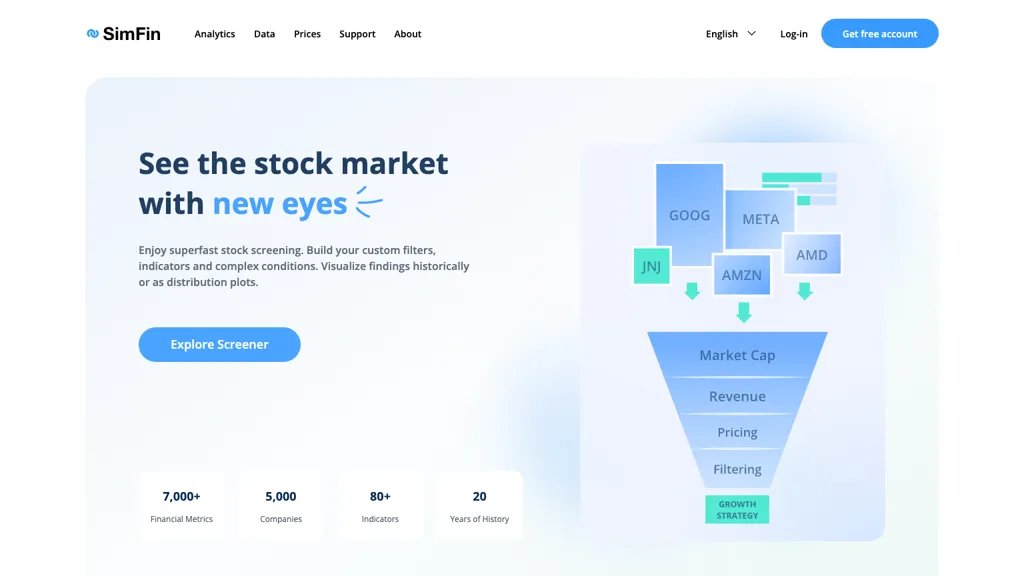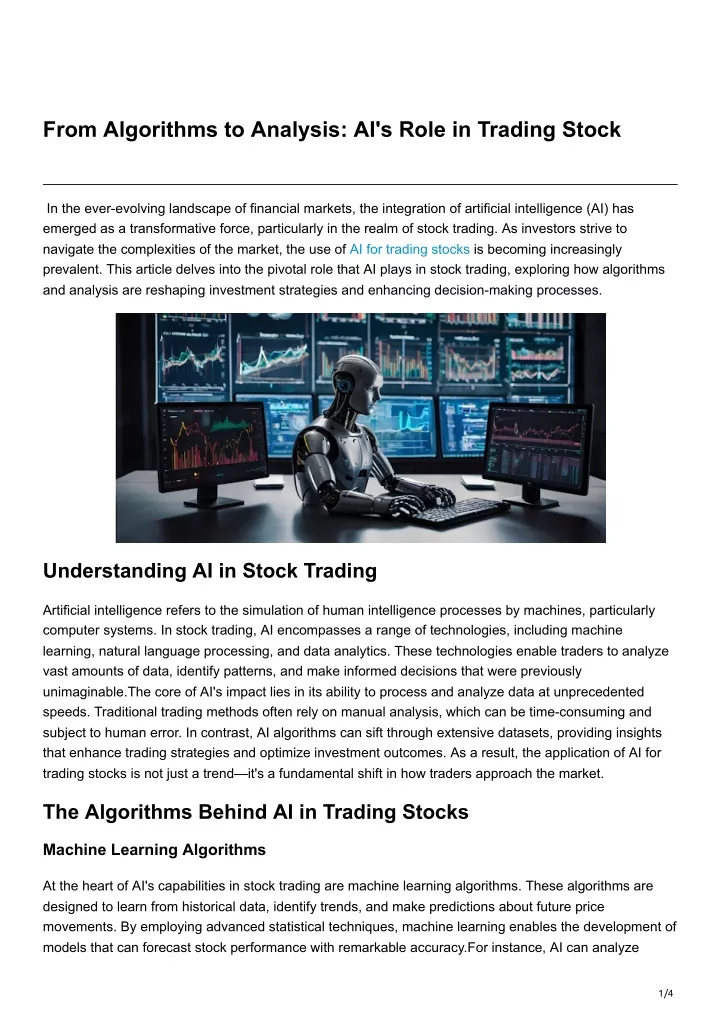20 Top Facts To Picking AI Stock Picker Analysis Sites
20 Top Facts To Picking AI Stock Picker Analysis Sites
Blog Article
Top 10 Tips To Assess The Strategy Customization Of Ai Trading Platforms
AI trading platforms that can predict or analyze stocks are renowned for their ability to customize strategies that meet the requirements of users. This lets them adjust to specific goals and conditions, which includes risk tolerance. A platform that offers extensive customization options can greatly improve the efficiency of your trading. Here are 10 top suggestions for evaluating the customization options offered by these platforms.
1. Evaluate Pre-Built Strategy Templates
A Variety of Templates: Check whether the platform you are using offers pre-built templates for various trading styles (e.g. Day Trading or Swing Trading, Long-Term Investing).
Utilizability: Find out how easily these templates can be altered to meet your specific needs.
Performance history: See if you can access historical information about the performance of pre-built strategies.
2. Create a custom strategy
Drag-and-drop tools: Look for platforms that offer intuitive drag-and-drop interfaces to design custom strategies.
Check the platform's coding options. Advanced users may want to utilize custom scripting language (e.g. Python or R).
Flexibility: Make sure the platform lets you define entry/exit rules, risk management parameters, as well as other important elements of your strategy.
3. Check for Backtesting Capabilities
Historical data: Check if your platform offers enough historical data to test backtesting strategies.
Customizable parameters - Ensure that you can change parameters (e.g. timeframes, indicators) during backtesting.
Performance metrics: See whether the platform offers precise performance metrics (e.g., win rate Sharpe ratio drawdown) for strategies that have been tested back.
4. Evaluate Real-Time Strategy Testing
Paper trading Strategies can be tested in real time using paper trading or simulation.
Live testing - Make sure that you can test strategies with small amounts of money to see how they perform.
Real-time adjustments: Check to see if your strategy can be adjusted in real time according to market conditions.
5. Assess Integration with Technical Indicators
Find out if there's an indicator library.
Custom indicators: Ensure you can import or create custom indicators to match your strategies.
Combinations of indicators: Check whether the platform supports the combination of several indicators to make more complex strategies.
6. Check for Risk Management Tools
Stop-loss/take-profit: Ensure the platform allows you to set stop-loss and take-profit levels within your strategies.
Position sizing: Check whether you have the ability to establish guidelines for the size of your portfolio (e.g. Fixed amount, percentage of your portfolio) to control the risk.
Rate of risk-reward: Check if the platform allows the setting of specific risk-reward rate rates for strategies or for individual trades.
7. Evaluate Multi-Asset Strategy Support
Asset classes: Make sure that the platform supports strategies across different asset classes (e.g., stocks, ETFs, options and forex).
Strategies for cross-assets : You can make strategies that involve different asset classes (e.g. pairs trading hedges, pair trading).
Market coverage: Ensure that the platform you are interested in has market coverage for the markets that interest you (e.g. US or international, copyright).
8. Evaluate Automation and Execution
Automated Trading: Check that the platform can execute strategies automatically using pre-defined rules.
Types of orders - Make sure that the platform supports a range of order types for execution strategies (e.g. stop, limit or market).
The Latency Checker: Ensure that the platform allows for transactions to be completed with minimum delay. This is crucial for high-frequency strategy.
9. Look for tools to optimize your strategy.
Parameter optimization. Check that your platform permits you to optimize the parameters of your plan (e.g. Grid search, Genetic algorithms).
Machine Learning Integration: Determine whether a platform incorporates machine-learning to improve and refine strategy.
Scenario Analysis: Determine whether the platform allows testing strategies for different market scenarios (e.g. bull bear, bear, volatile).
Review Community Feedback and User Feedback
User reviews: Read user feedback in order to determine the platform's capacity to tailor strategies.
Forums for community members: See whether you can locate a forum where users discuss and share custom strategies.
Support resources: Ensure that the platform offers tutorials, webinars or documentation to help users create and optimize strategies.
Bonus Tips
Trial period: Try the platform's customisation features with a free demo or trial.
Scalability: Ensure the platform is able to manage complex strategies that change as you trade.
Customer support: Find out if there is support available for inquiries or concerns relating to strategy.
If you follow these guidelines, you can effectively assess the ability to tailor strategies for AI platforms for analyzing and predicting stocks Be sure to select a platform that aligns with your trading goals and allows you to implement and refine your strategies efficiently. A platform with robust customization capabilities can allow you to adapt to market conditions and enhance your trading performance. Follow the best for beginners on market ai for more tips including ai stocks, best ai stock trading bot free, ai stock market, best ai trading app, best ai stock, stock ai, ai investing, options ai, using ai to trade stocks, chatgpt copyright and more.
Top 10 Suggestions For Evaluating The Reputation, Reviews And Comments On Ai Stock Trading Platforms
It is important to assess the reviews and reputation of AI-driven trading and stock prediction platforms to be sure of their reliability, trustworthiness, and effectiveness. These are the top 10 suggestions to evaluate their reputation and reviews:
1. Check Independent Review Platforms
Tips: Search for reviews on trustworthy platforms such as G2, copyright, or Capterra.
Why: Independent platforms can provide users with real-time feedback.
2. Examine Case Studies and User Testimonials
Use the platform website to read user testimonials, case studies as well as other relevant information.
The reason: They offer insights into the performance of real-world applications as well as user satisfaction and other aspects.
3. Review Expert Opinions and Industry Recognition
TIP: Check whether any industry experts, analysts, or publications of repute have viewed the platform or made a recommendation.
Expert endorsements lend credibility to claims made by the platform.
4. Social Media Sentiment
Tip: Check social media platforms for discussion and opinions on the platform (e.g. Twitter, LinkedIn, Reddit).
What's the reason? Social media are a wonderful source of unfiltered opinions, trends and information about the platform.
5. Verify Compliance with Regulatory Regulations
Tips: Make sure the platform complies with financial regulations (e.g., SEC, FINRA) and data privacy laws (e.g. GDPR).
Why: Compliance assures the platform is operating legally and ethically.
6. Find out if performance metrics are transparent. measures
Tip : Determine whether the platform provides transparent performance metrics.
Transparency increases trust and allows users of the platform to assess the effectiveness of the platform.
7. Check the Quality of Customer Support
You can read reviews to see how responsive and effective the customer service can be.
Why? Reliable support is vital to resolve any issue and ensuring a pleasant customer experience.
8. Red Flags to Look for in reviews
Tips: Be aware of frequent complaints, such as poor service, hidden charges, or a lack of updates.
Why? Consistently negative feedback may indicate problems in the system.
9. Study user engagement and community
Tips: Ensure that the platform is in use and is regularly engaging its users (e.g. forums, Discord groups).
Why? A strong community indicates that customers are satisfied and continue to provide assistance.
10. Check out the history of the company.
Explore the past performance of the company performance, its management, and the overall performance of the financial technology sector.
The reason: Having a track record of records increases confidence and trust on the platform.
Bonus Tip: Compare Multiple Platforms
Compare the reviews and reputation of different platforms to find out which is the best for you.
With these suggestions You can look over the credibility and reviews of AI-based trading and stock prediction solutions to ensure that you select an efficient and reliable option. Check out the top ai stock price prediction for more tips including ai in stock market, stock trading ai, ai tools for trading, ai investment tools, ai in stock market, ai stock price prediction, best ai stocks, ai share trading, invest ai, best ai penny stocks and more.